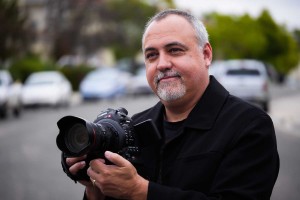
Director of photography Erik Naso was recently called on to create a series of three promos for NBC 7 San Diego’s news programs. As a former photojournalist, Naso knew that large-format, single-sensor cameras provide the shallow depth of field he needed to create the cinematic-style he was going for.
Naso wanted each spot to have a cinematic quality that differed from the station’s regularly aired ENG-style videos. He chose to shoot with Canon’s Cinema EOS C100 digital video camera, which features a Super 35mm CMOS image sensor. As a longtime user of digital SLR cameras – including Canon’s EOS 5D Mark II – Naso appreciated the ergonomics of the EOS C100 camera, and its ability to use all of the Canon EF-Series photographic lenses he already owns.
“With ENG cameras, you don’t have control of depth of field,” said Naso. “If you want to control it, you have to have a longer lens, zoom in from far away, or zoom in to compress the background to create a shallow depth of field. With the Canon EOS C100 camera, you can be five feet away, open up your iris, and adjust your neutral density (ND) filters to gain more shallow depth of field or more control over that look, which makes production so much easier.”
The EOS C100 camera body without accessories weighs just 2.2 lbs. and includes a removable, side-mounted rotating pistol grip, which Naso found convenient for various shooting styles. Naso’s promo shoot entailed two 10-hour days of filming the station’s anchors and reporters “documentary-style” as they walked through city streets, so weight and form factor were a major consideration for him when choosing a camera. He cited multiple features of the Canon EOS C100 digital video camera as having been crucial to his needs. In particular, he found the camera’s control buttons and pistol grip to be conveniently located.
“The f-stop dial, magnification controller and a mini joystick navigator are right on the pistol grip, which puts them – including the record button – right at my fingertips,” he explained. “Canon really thought this out on the EOS C100 camera. The grip is removable, so if you want to create some sort of shoulder rig or change it ergonomically, you can take the grip off and add an extender to it. The options are there for a third party to get involved and make accessories to allow for different configurations, and that is just awesome.”
The Canon EOS C100 camera’s function buttons are reprogrammable, allowing the operator to reassign them for a specific purpose and shoot in the style he/she prefers. “Having those buttons where you already have your hand when shooting, and being able to get the access easily to those buttons, is a major advantage,” said Naso.
The EOS C100 camera records 1920×1080 HD video using MPEG-4 AVC/H.264 compression at data rates of up to 24-Mbps to two low-cost SD cards. A single 32GB SD card can hold nearly three hours of high-quality HD at 24 Mbps, while the dual SD card slots found on the camera can provide for backup and relay recording. The EOS C100 camera can also output uncompressed digital HD to an external recording device via its locking HDMI connector.
Naso’s favorite features for adjusting the 1920 x 1080 HD image of the Canon EOS C100 camera are its autofocus button, its magnification capabilities and its built-in waveform monitor. “I really like where Canon put the autofocus button,” he said. “Instead of being on the side of the body, it’s down on the bottom front corner, the closest button to the lens. So you can just touch that and right away you get your autofocus nice and close.”
 “Being able to use the magnification feature, to zoom-in when you are recording is a gift,” Naso continued. “It really helps you obtain the proper focus, because when you visually go into it and focus on somebody’s eyes, and you see them sharply, there is no doubt about whether they’re in focus. It’s reassuring. Peaking can give you this sharpness around a detailed area, but it can be deceptive. Your viewfinder or your detail setting could be right, but they could also be too high or too forgiving of your camera, and then you’re not really seeing what you’re supposed to be seeing. With the magnification on the EOS C100 camera, you can – at the touch of a button – zoom in, and even if it’s not zoomed in on your subject’s face – if you can just tell by his or her shirt that they are in focus – then you’re good.”
“Being able to use the magnification feature, to zoom-in when you are recording is a gift,” Naso continued. “It really helps you obtain the proper focus, because when you visually go into it and focus on somebody’s eyes, and you see them sharply, there is no doubt about whether they’re in focus. It’s reassuring. Peaking can give you this sharpness around a detailed area, but it can be deceptive. Your viewfinder or your detail setting could be right, but they could also be too high or too forgiving of your camera, and then you’re not really seeing what you’re supposed to be seeing. With the magnification on the EOS C100 camera, you can – at the touch of a button – zoom in, and even if it’s not zoomed in on your subject’s face – if you can just tell by his or her shirt that they are in focus – then you’re good.”
The EOS C100 is an EF-mount camera compatible with Canon’s array of more than 60 EF-Series prime and zoom photographic lenses (including macro, fisheye, telephoto, and tilt-shift models). A user of Canon’s digital SLR cameras, therefore, can employ the lenses he or she may already own with the EOS C100 camera to achieve a wide range of creative choices. The EOS C100 digital video camera can also be used with the EF-mount versions of Canon’s Cinema zoom and Cinema prime lenses. Although Naso prefers the Canon EF 24-105mm f/4L IS USM zoom lens for the EOS C100 camera, he has also uses the Canon EF-70-200mm f/4L IS USM telephoto zoom and the EF 50mm f/1.8 II standard lenses, which are a part of his lens collection.
“You can use any EF or EF-S lens on the EOS C100 camera, which is pretty amazing,” said Naso. “Being able to carry across a lens, especially one from the EOS 5D Mark II or EOS 5D Mark III digital SLR cameras to the EOS C100 digital video camera really gives you a tremendous amount of flexibility.”
Naso chose to shoot the promos using the C100’s Log Gamma setting, which records images with subdued contrast and sharpness, preserving a high dynamic range for postproduction color grading. “Being able to shoot Canon Log allows me to open up my shadows, so when I’m editing, I can decide if I want viewers to see in the shadows or not,” Naso explained. “If I don’t have that exposure in the shadows, if I bake that look and I’m crushing my blacks already in the camera, and then I decide I want you to see into those shadows, that information is lost without the Canon Log. So, it’s important that I have that control. I use Adobe Premiere Pro CS6 and edit natively off that. I feed the card to my hard drive, which allows me to edit without having to do any transcoding. I like it because it’s less compressed, which makes it faster to edit.”
Naso’s results with the Canon EOS C100 digital video camera prompted his station to purchase a Canon EOS C300 camera for future work.
“Large-sensor cameras have changed the way I shoot and produce, and have enabled the station I work for to differentiate itself in the market,” Naso concluded. “The Canon EOS C100 is the most ergonomic camera I’ve used so far. It’s easy to hand hold, so I could shoot with it all day. With the EOS C100 camera, I’m now thinking more about the composition and how the background will play into it. It’s really opened up my creative potential.”





